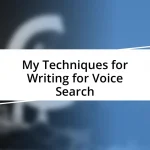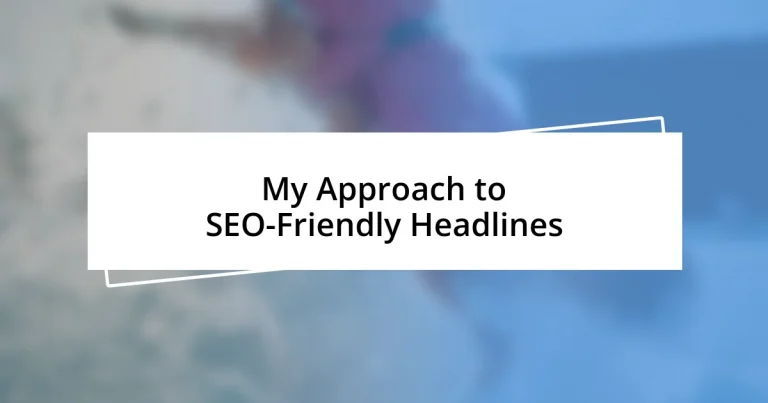Key takeaways:
- SEO-friendly headlines combine emotional triggers, relevant keywords, and a clear structure to attract the right audience and improve engagement.
- Catching attention requires balancing length and intrigue, with successful headlines typically around 50-60 characters and often utilizing numbers.
- Testing and analyzing headlines using tools and audience feedback are crucial for optimizing performance and understanding what resonates with readers.

Understanding SEO-Friendly Headlines
SEO-friendly headlines are more than just catchy phrases; they are strategic tools that help your content get discovered. I remember the first time I experimented with keywords, and the difference it made. Suddenly, my blog traffic spiked, and it hit me—headlines could wield that kind of power. What if you could attract the right audience by simply tweaking a few words?
When creating these headlines, think about your readers’ intent. Are they searching for a solution, or are they looking to be informed? I often put myself in their shoes, imagining their questions and needs. It’s fascinating how a well-structured headline can resonate with someone’s specific search, compelling them to click through.
Moreover, incorporating emotional triggers can significantly enhance engagement. I once wrote a headline that sparked curiosity and urgency, and my analytics reflected the excitement. That taught me that mixing emotion with actionable phrases makes headlines irresistible. Are you ready to craft your headlines in a way that speaks directly to your audience’s desires?

Importance of Catchy Headlines
Catchy headlines serve as the gateway to your content, positioning you to capture the attention of your audience. I remember one particular piece I wrote where the headline practically told a story. Instead of a bland title, I opted for something intriguing, and the result was a significant boost in shares and readers. It’s incredible how a mere shift in wording can ignite curiosity and drive traffic.
Consider these key points about catchy headlines:
– They instantly convey the value of your content, guiding potential readers on what to expect.
– A compelling headline can elicit an emotional response, prompting clicks.
– They improve your search engine visibility by integrating relevant keywords people are actually searching for.
– Engaging headlines often encourage social sharing, expanding your content’s reach.
Authentically capturing attention through a catchy headline is not just an art, but a critical strategy for successful engagement in this digital age.

Keywords in Your Headlines
When I first started fine-tuning my headlines with keywords, it felt like flipping a switch. Embedding relevant keywords right at the start often made all the difference in search rankings. For instance, when I used “easy recipes for busy parents” instead of just “recipes,” I noticed that my post attracted a more targeted audience looking for exactly what I offered.
Let’s not overlook the balance between compelling language and keyword placement. While keywords help with visibility, they shouldn’t disrupt the natural flow of your title. I remember crafting a headline with keywords that maintained a conversational tone, and it really resonated. Readers clicked through, not just for the information, but because they felt understood and valued.
To see the impact clearly, I began tracking my headlines. Each time I incorporated a keyword effectively, I watched my click-through rates improve. It felt exhilarating to witness the direct connection between thoughtful keyword integration and increased audience engagement. Have you considered experimenting with keyword placement in your headlines? It’s a rewarding journey.
| Keyword Placement | Focus and Engagement |
|---|---|
| Essential for SEO | Captivating reader interest |
| Targets specific searches | Aids in establishing relevance |
| Direct impact on traffic | Creates a personal touch |

Structure and Length of Headlines
There’s something to be said for the structure of headlines. I’ve found that a well-structured headline typically follows a formula: it includes a clear subject, a verb, and a promise of value. For example, when I crafted “Boost Your Productivity with These 5 Simple Tips,” it presented an action, a benefit, and a number that sparks curiosity. Makes you wonder, doesn’t it? How can five simple tips change your day?
In terms of length, striking a balance is essential. Too short, and you risk being vague; too long, and you might lose the reader’s attention. Personally, I tend to aim for headlines that are around 50 to 60 characters long. This range helps in keeping search engines happy while still being digestible for readers. I remember a time when I strayed from this guideline, and my audience responded with disinterest—my view count plummeted. How frustrating it can be when your hard work goes unrecognized due to a headline that’s not quite right!
Additionally, utilizing numbers often increases engagement. I once created a headline that read, “7 Secrets to Perfectly Cooked Steak,” and to my surprise, it drew in readers like a magnet. Numbers provide specificity and promise a digestible format that people can follow. It’s an interesting thought: in our fast-paced world, we often seek clarity and brevity, so why not cater to that with our headlines?

Testing and Analyzing Headlines
Testing your headlines is an exciting process that can yield surprising insights. I remember running a simple A/B test with two variations of the same headline. One focused on urgency while the other promised a solution. The difference in engagement was eye-opening—what I thought would resonate didn’t quite hit the mark! It really drove home the point that we can’t always predict what will bring in clicks or conversions.
Once I grasped the importance of testing, I began using tools like Google Analytics to deep dive into performance metrics. I watched as certain headlines dramatically outperformed others. It was a fulfilling challenge to analyze the data, and I found patterns in which styles and keywords sparked interest within my target audience. Have you ever experienced that “lightbulb moment” when a headline unexpectedly takes off? It’s those revelations that fuel my creativity.
Analyzing headlines is about more than numbers; it’s about understanding your readers. I recall when I tailored a headline based on feedback from a loyal subscriber. That personal touch turned out to be a game changer, making them more likely to share the content. Connecting with your audience through thoughtful analysis elevates your writing, don’t you think? It transforms mere words into a conversation, encouraging engagement and building a community around your brand.

Tools for Creating Headlines
There are several fantastic tools for crafting attention-grabbing headlines. I’ve come across platforms like CoSchedule’s Headline Analyzer, which provides scores based on various criteria, including word balance and emotional appeal. I remember the first time I used it; the evaluation nudged me to reconsider every word I chose. It was a bit like having an insightful friend guiding me, helping me tighten my language into something truly compelling.
Another tool I’ve found invaluable is the Emotional Marketing Value Headline Analyzer. It takes your headlines and evaluates the emotional word content. When I tried this out, I was amazed at how tweaking a few words transformed a flat headline into something that resonated deeply with my audience. Have you ever felt that rush when you realize your words can provoke laughter, intrigue, or even a response? It’s rewarding to know that tools can amplify this potential.
Lastly, I often explore social media platforms for headline inspiration. Scrolling through engaging posts, I jot down what catches my eye. One time, a tweet with a simple question packed so much curiosity that I had to click. It made me realize that sometimes the best tool lies in observing real conversations online to inspire our own headlines. How do you discover what resonates with your audience? It’s all about tapping into those genuine interactions, don’t you agree?

Best Practices for SEO Headlines
Creating SEO-friendly headlines is a blend of art and science. One practice I swear by is incorporating relevant keywords without forcing them. I’ve learned that a headline crafted naturally around primary keywords catches attention better than one that feels stuffed. I once focused on a headline that used the keyword “simple recipes.” Instead of a basic structure, I framed it as “Simple Recipes for Busy Weeknights,” which resonated more, drawing in readers who identified with the struggle of juggling time and cooking.
Another crucial tactic is to keep it concise yet intriguing. The ideal headline is often between 50-60 characters, which I find is short enough to fit into search results without getting cut off. A few months ago, I faced a dilemma with a lengthy headline. After some editing, I turned “Essential Tips for Achieving a Stress-Free Morning Routine” into “Stress-Free Mornings: Essential Tips.” The engagement soared, confirming my belief that clarity and brevity often win over complexity.
I can’t stress enough the value of urgency and curiosity in headlines. For instance, when writing about marketing, I once titled an article “Double Your Marketing ROI in 30 Days!” The response was massive, evoking excitement and prompting action. This makes me wonder, how often do we overlook the power of a well-placed exclamation point or a quantifiable promise? Crafting headlines that instill a sense of urgency can be transformative—it’s like giving readers a gentle nudge that they can’t ignore. Wouldn’t you agree that a little excitement can go a long way in making our headlines pop?














